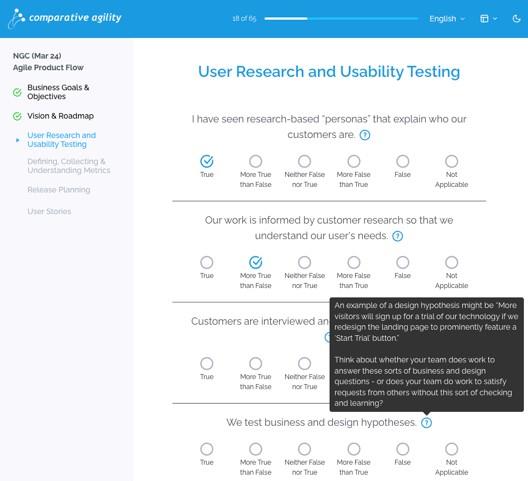OUR ASSESSMENTS
Getting Started with Assessments
RIK DRYFOOS
Where Should They Start?
When a team aims to build better software faster, where should they start?
Many popular frameworks for agility overlook the organization's current state, leading to a transformation process that demands learning an overwhelming amount of new vocabulary, roles, and processes simultaneously, and all before team members fully grasp the necessity of these changes.
A kinder, gentler approach—and one that yields far better results—starts by meeting teams where they are. This involves instrumenting processes as needed to gather data and initiating targeted improvements. Such a strategy not only leads to better outcomes but also enhances the team's understanding of which further changes could be beneficial.
Agility assessments are our compass to help navigate through the intricate landscape of organizational improvement. Beginning with an assessment isn't just a procedural step—it's a critical move that uncovers hidden issues, leading to significant savings in time, money and resources.
Why Start with an Assessment?
It provides a quick on-ramp to understanding each team's unique needs, ensuring targeted and effective interventions. This clarity helps us prioritize actions, enabling more efficient work at scale and consistent coaching across teams.
We Leverage a six-topic, sixty-six question assessment, where team members use a Likert scale to indicate the presence of absense of specific behaviors.

Our Agile Product Flow assessment sets itself apart by checking for the presence of positive behaviors rather than merely looking for compliance with rules, as many assessments do. This approach emphasizes the cultivation of constructive, modern practices that contribute directly to team effectiveness and information flow efficiency. By focusing on what teams are doing right, we encourage a culture of continuous improvement and innovation.
This perspective also promotes a more engaging and motivational assessment experience for team members. It shifts the conversation from “Are we following the rules?” to “How can we work even better together?" fostering an environment where positive change is recognized and celebrated. Through this lens, our assessments are not just evaluative tools but catalysts for growth, guiding teams towards operational excellence and a thriving work environment by highlighting strengths and identifying opportunities for further development.
Why our Methodology?
Our Digital Transformation methodology aims not just at faster product development but also at enhancing the work life. It increases leadership visibility, improves team request quality, and identifies the most adaptable teams—laying the foundation for a sustainable continuous improvement environment.
Our methodology helps you navigate through common pitfalls like varying team knowledge and the allure of vanity metrics by refining our assessment framework to be both robust and adaptable. This ensures its relevance amid evolving methodologies and technologies.
The outcome of our assessments offers a comprehensive roadmap for action, highlighting strengths, pinpointing weaknesses, and providing resources to guide teams toward greater agility fluency.
In essence, our assessments are the starting point for a strategic and sustainable journey of continuous improvement. They mark the beginning of a path to not only operational excellence but also a thriving work environment for every team member.
